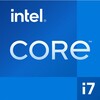AMD Ryzen 7 PRO 6850HS vs Intel Core i7-13620H
AMD Ryzen 7 PRO 6850HS
► remove from comparison
The AMD Ryzen 7 PRO 6850HS is a processor for big (workstation) laptops based of the Rembrandt generation. The R7 6850HS integrates all eight cores based on the Zen 3+ microarchitecture. They are clocked at 3.2 (guaranteed base clock) to 4.7 GHz (Turbo) and support SMT / Hyperthreading (16 threads). The chip is manufactured on the modern 6 nm TSMC process. The HS variant offers a 10 W reduced TDP and therefore a lower sustained performance than the H version. The 6850HS is the professional version of the consumer R7 6800HS with additional management features and the Microsoft Pluton Security processor.
The new Zen 3+ is a refresh of the Zen 3 architecture and should not offer a lot of changes. The chip itself however, offers a lot of new features, like support for USB 4 (40 Gbps), PCI-E Gen 4, DDR5-4800MT/s or LPDDR5-6400MT/s, WiFi 6E, Bluetooth LE 5.2, DisplayPort 2, and AV1 decode.
A big novelty is the integrated GPU Radeon 680M, that is now based on the RDNA2 architecture and offers 12 CUs at up to 2.2 GHz. It should be the fastest iGPU of all at the time of announcement.
Performance
While we have not tested a single system powered by the 6850HS as of August 2023, it's safe to expect the chip to be about as fast as the 6800HS and the 6850H.
Your mileage may vary depending on how high the CPU power limits are and how competent the cooling solution of your system is.
Power consumption
This Ryzen 7 has a default TDP of 35 W (also known as the long-term power limit). Which is way too high to allow it to become a heart of a passively cooled laptop, tablet, mini-PC.
The APU is manufactured on TSMC's 6 nm process leading to great, as of late 2022, energy efficiency.
Intel Core i7-13620H
► remove from comparison
The Intel Core i7-13620H is a high-end mobile CPU for laptops of the Raptor Lake-H series (based on the Alder Lake architecture). It was announced in early 2023 and offers 6 performance cores (P-cores, Golden Cove architecture) and 4 of the 8 efficient cores (E-cores, Gracemont architecture). The P-cores support Hyper-Threading leading to 16 supported threads when combined with the E-cores. The clock rate ranges from 2.4 to 4.9 GHz (single-core boost, all-core boost up to 4.7 GHz) on the performance cluster and 1.8 to 3.6 GHz on the efficient cluster. The performance of the E-cores should be similar to old Skylake cores (compare to the Core i7-6700HQ). All cores can use up to 24 MB L3 cache. Compared to the older i7-12650H, the 13620H offers higher clock speeds.
Performance
Thanks to the improved clock speeds, the i7-13620H should be able to clearly best the old i7-12650H. Still, the faster i7 models of the 13th gen offer more e-Cores and therefore a clearly better multi-threaded performance.
Features
The integrated memory controller supports various memory types up to DDR5-5200 (up from DDR5-4800 of the 12th gen.). The Thread Director (in hardware) can support the operating system to decide which thread to use on the performance or efficient cores for the best performance. For AI tasks, the CPU also integrates GNA 3.0 and DL Boost (via AVX2). Quick Sync in version 8 is the same as in the Rocket Lake CPUs and supports MPEG-2, AVC, VC-1 decode, JPEG, VP8 decode, VP9, HEVC, and AV1 decode in hardware. The CPU now supports PCIe 5.0 x8 for a GPU and two PCIe 4.0 x4 for SSDs.
The integrated graphics card is based on the Xe-architecture and offers 64 of the 96 EUs (Execution Units) clocked at up to 1.5GHz.
Power consumption
The i7-13620H is rated at a TDP of 55W (PL1, 115W PL2) and is manufactured in a further improved 10nm process (Intel 7) that allows the higher clock speeds compared to the 12th gen CPUs.
| Model | AMD Ryzen 7 PRO 6850HS | Intel Core i7-13620H | ||||||||||||||||||||||||||||||||||||||||||||||||||||||||||||||||||||
| Codename | Rembrandt-HS (Zen 3+) | Raptor Lake-H | ||||||||||||||||||||||||||||||||||||||||||||||||||||||||||||||||||||
| Series | AMD Rembrandt (Zen 3+) | Intel Raptor Lake-H | ||||||||||||||||||||||||||||||||||||||||||||||||||||||||||||||||||||
| Series: Raptor Lake-H Raptor Lake-H |
|
| ||||||||||||||||||||||||||||||||||||||||||||||||||||||||||||||||||||
| Clock | 3200 - 4700 MHz | 1800 - 4900 MHz | ||||||||||||||||||||||||||||||||||||||||||||||||||||||||||||||||||||
| L1 Cache | 512 KB | 864 KB | ||||||||||||||||||||||||||||||||||||||||||||||||||||||||||||||||||||
| L2 Cache | 4 MB | 9.5 MB | ||||||||||||||||||||||||||||||||||||||||||||||||||||||||||||||||||||
| L3 Cache | 16 MB | 24 MB | ||||||||||||||||||||||||||||||||||||||||||||||||||||||||||||||||||||
| Cores / Threads | 8 / 16 | 10 / 16 6 x 4.9 GHz Intel Golden Cove P-Core 4 x 3.6 GHz Intel Gracemont E-Core | ||||||||||||||||||||||||||||||||||||||||||||||||||||||||||||||||||||
| TDP | 35 Watt | 45 Watt | ||||||||||||||||||||||||||||||||||||||||||||||||||||||||||||||||||||
| Technology | 6 nm | 10 nm | ||||||||||||||||||||||||||||||||||||||||||||||||||||||||||||||||||||
| max. Temp. | 95 °C | 100 °C | ||||||||||||||||||||||||||||||||||||||||||||||||||||||||||||||||||||
| Socket | FP7/FP7r2 | BGA1700 | ||||||||||||||||||||||||||||||||||||||||||||||||||||||||||||||||||||
| Features | DDR5-4800/LPDDR5-6400 RAM (incl. ECC), PCIe 4, PRO, MMX, SSE, SSE2, SSE3, SSSE3, SSE4A, SSE4.1, SSE4.2, AVX, AVX2, BMI2, ABM, FMA, ADX, SMEP, SMAP, SMT, CPB, AES-NI, RDRAND, RDSEED, SHA, SME | Thread Director | ||||||||||||||||||||||||||||||||||||||||||||||||||||||||||||||||||||
| iGPU | AMD Radeon 680M ( - 2200 MHz) | Intel UHD Graphics 64EUs (Alder Lake 12th Gen) ( - 1500 MHz) | ||||||||||||||||||||||||||||||||||||||||||||||||||||||||||||||||||||
| Architecture | x86 | x86 | ||||||||||||||||||||||||||||||||||||||||||||||||||||||||||||||||||||
| Announced | ||||||||||||||||||||||||||||||||||||||||||||||||||||||||||||||||||||||
| Manufacturer | www.amd.com | ark.intel.com |
Benchmarks
Average Benchmarks Intel Core i7-13620H → 0% n=0
* Smaller numbers mean a higher performance
1 This benchmark is not used for the average calculation













